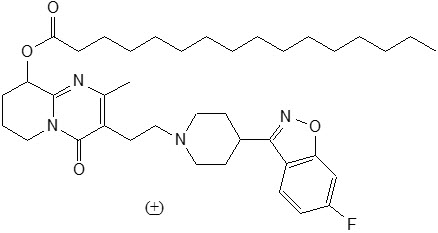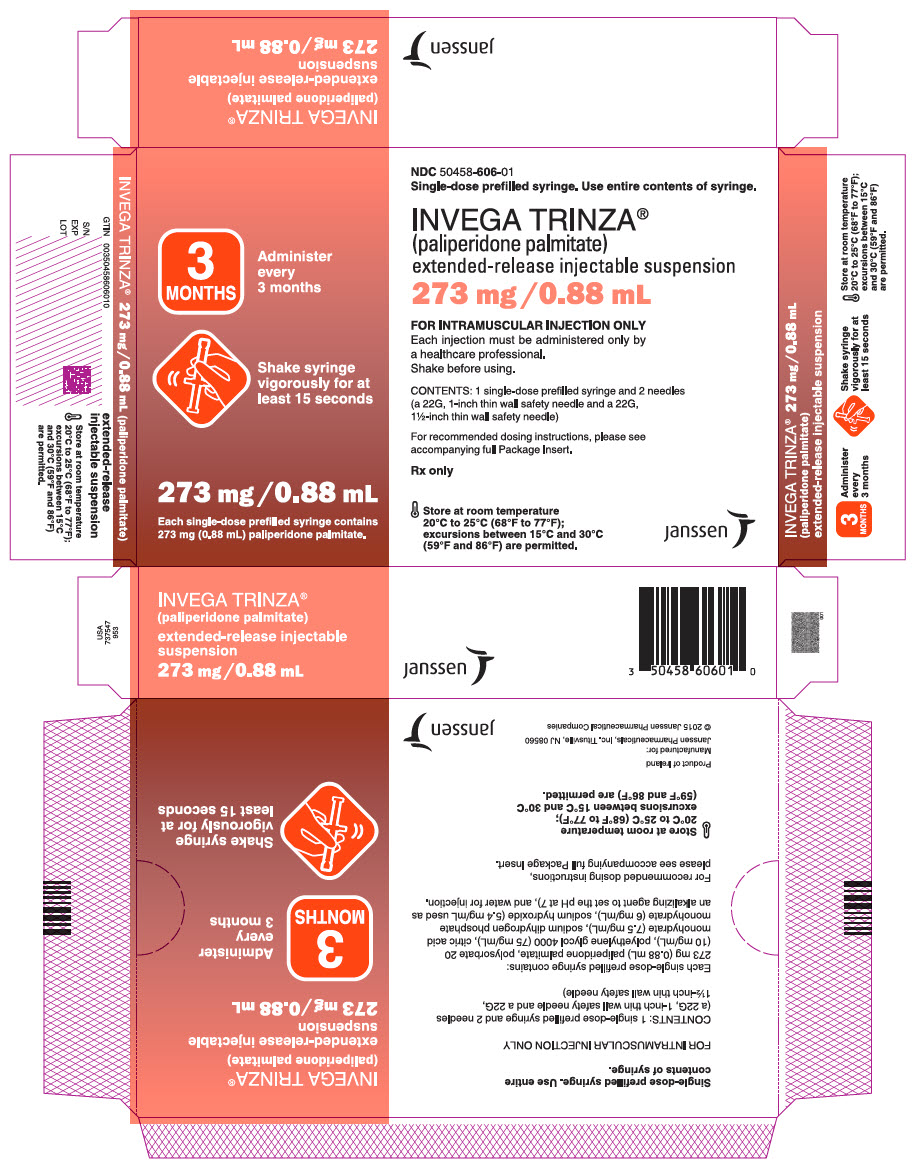Invega Trinza
Generic name: paliperidone palminate
Dosage form: extended-release suspension for intramuscular injection
Drug class: Atypical antipsychotics
Medically reviewed by A Ras MD.
What is Invega Trinza?
Invega Trinza is a prescription medicine given by injection by a health care professional and used to treat schizophrenia.
Invega Trinza is used in people who have been treated with Invega Trinza 1 time a month injections for at least 4 months.
It is not known if Invega Trinza is safe and effective in children under 18 years of age.
Description
INVEGA TRINZA® contains paliperidone palmitate. The active ingredient, paliperidone, is an atypical antipsychotic belonging to the chemical class of benzisoxazole derivatives. INVEGA TRINZA® contains a racemic mixture of (+)- and (-)- paliperidone palmitate. The chemical name is (9RS)-3-[2-[4-(6-Fluoro-1,2-benzisoxazol-3-yl)piperidin-1-yl]ethyl]-2-methyl-4-oxo-6,7,8,9-tetrahydro-4H-pyrido[1,2-a]pyrimadin-9-yl hexadecanoate. Its molecular formula is C39H57FN4O4 and its molecular weight is 664.89. The structural formula is:

Paliperidone palmitate is very slightly soluble in ethanol and methanol, practically insoluble in polyethylene glycol 400 and propylene glycol, and slightly soluble in ethyl acetate.
INVEGA TRINZA® is available as a white to off-white sterile aqueous extended-release suspension for intramuscular injection in dose strengths of 273 mg, 410 mg, 546 mg, and 819 mg paliperidone palmitate in single-dose prefilled syringes. The drug product hydrolyzes to the active moiety, paliperidone, resulting in dose strengths of 175 mg, 263 mg, 350 mg, and 525 mg of paliperidone, respectively. The inactive ingredients are polysorbate 20 (10 mg/mL), polyethylene glycol 4000 (75 mg/mL), citric acid monohydrate (7.5 mg/mL), sodium dihydrogen phosphate monohydrate (6 mg/mL), sodium hydroxide (5.4 mg/mL used as an alkalizing agent to set the pH at 7), and water for injection.
INVEGA TRINZA® is provided in a single-dose prefilled syringe (cyclic-olefin-copolymer) with either 175 mg (0.88 mL), 263 mg (1.32 mL), 350 mg (1.75 mL), or 525 mg (2.63 mL) paliperidone (as 273 mg, 410 mg, 546 mg, or 819 mg paliperidone palmitate) suspension with a plunger stopper and tip cap (bromobutyl rubber), a backstop, and 2 types of commercially available needles: a thin walled 22G, 1 ½-inch safety needle and a thin walled 22G, 1-inch safety needle.
Mechanism of Action
Paliperidone palmitate is hydrolyzed to paliperidone. Paliperidone is the major active metabolite of risperidone. The mechanism of action of paliperidone is unclear. However, the drug’s therapeutic effect in schizophrenia could be mediated through a combination of central dopamine Type 2 (D2) and serotonin Type 2 (5HT2A) receptor antagonism.
What is the most important information I should know about Invega Trinza?
Invega Trinza can cause serious side effects, including:
- Increased risk of death in elderly people who are confused, have memory loss and have lost touch with reality (dementia-related psychosis). Invega Trinza is not for treating dementia-related psychosis.
Who should not use Invega Trinza?
Do not receive Invega Trinza if you:
- are allergic to paliperidone palmitate, risperidone, or any of the ingredients in Invega Trinza. See the end of this Patient Information leaflet for a complete list of ingredients in Invega Trinza.
What should I tell my healthcare provider before using Invega Trinza?
Before you receive Invega Trinza, tell your healthcare provider about all your medical conditions, including if you:
- have had Neuroleptic Malignant Syndrome (NMS)
- have or have had heart problems, including a heart attack, heart failure, abnormal heart rhythm, or long QT syndrome
- have or have had low levels of potassium or magnesium in your blood
- have or have had uncontrolled movements of your tongue, face, mouth, or jaw (tardive dyskinesia)
- have or have had kidney or liver problems
- have diabetes or have a family history of diabetes
- have had a low white blood cell count
- have had problems with dizziness or fainting or are being treated for high blood pressure
- have or have had seizures or epilepsy
- have any other medical conditions
- are pregnant or plan to become pregnant. It is not known if Invega Trinza will harm your unborn baby.
- If you become pregnant while taking Invega Trinza, talk to your healthcare provider about registering with the National Pregnancy Registry for Atypical Antipsychotics. You can register by calling 1-866-961-2388 or visit http://womensmentalhealth.org/clinical-and-research-programs/pregnancyregistry/.
- Infants born to women who are treated with Invega Trinza may experience symptoms such as tremors, irritability, excessive sleepiness, eye twitching, muscle spasms, decreased appetite, difficulty breathing, or abnormal movement of arms and legs. Let your healthcare provider know if these symptoms occur.
- are breastfeeding or plan to breastfeed. Invega Trinza can pass into your breast milk. Talk to your healthcare provider about the best way to feed your baby if you receive Invega Trinza.
Tell your healthcare provider about all the medicines you take, including prescription and over-the-counter medicines, vitamins, and herbal supplements.
Know the medicines you take. Keep a list of them to show to your healthcare provider or pharmacist when you get a new medicine.
How should I use Invega Trinza?
- Follow your Invega Trinza treatment schedule exactly as your healthcare provider tells you to.
- Your healthcare provider will tell you how much Invega Trinza you will receive and when you will receive it.
- Invega Trinza is given as an injection by your healthcare provider into the muscle (intramuscularly) of your arm or your buttocks, 1 time every 3 months.
What should I avoid while using Invega Trinza?
- Invega Trinza may affect your ability to make decisions, think clearly, or react quickly. Do not drive, operate heavy machinery, or do other dangerous activities until you know how Invega Trinza affects you.
- Avoid getting overheated or dehydrated.
What are the possible side effects of Invega Trinza?
Invega Trinza may cause serious side effects, including:
See “What is the most important information I should know about Invega Trinza?”
- stroke in elderly people (cerebrovascular problems) that can lead to death
- Neuroleptic Malignant Syndrome (NMS). NMS is a rare but very serious problem that can happen in people who receive Invega Trinza. NMS can cause death and must be treated in a hospital. Call your healthcare provider right away if you become severely ill and have any of these symptoms:
- high fever
- severe muscle stiffness
- confusion
- loss of consciousness
- changes in your breathing, heartbeat and blood pressure
- problems with your heartbeat. These heart problems can cause death. Call your healthcare provider right away if you have any of these symptoms:
- passing out or feeling like you will pass out
- dizziness
- feeling as if your heart is pounding or missing beats
- uncontrolled movements of your tongue, face, mouth, or jaw (tardive dyskinesia)
- metabolic changes. Metabolic changes may include high blood sugar (hyperglycemia), diabetes mellitus and changes in the fat levels in your blood (dyslipidemia), and weight gain.
- low blood pressure and fainting
- changes in your blood cell counts
- high level of prolactin in your blood (hyperprolactinemia). Invega Trinza may cause a rise in the blood levels of a hormone called prolactin (hyperprolactinemia) that may cause side effects including missed menstrual periods, leakage of milk from the breasts, development of breasts in men, or problems with erection.
- problems thinking clearly and moving your body
- seizures
- difficulty swallowing that can cause food or liquid to get into your lungs
- prolonged or painful erection lasting more than 4 hours. Call your healthcare provider or go to your nearest emergency room right away if you have an erection that lasts more than 4 hours.
- problems with control of your body temperature especially when you exercise a lot or spend time doing things that make you warm. It is important for you to drink water to avoid dehydration.
The most common side effects of Invega Trinza include: injection site reactions, weight gain, headache, upper respiratory tract infections, feeling restlessness or difficulty sitting still, slow movements, tremors, stiffness shuffling walk.
Tell your healthcare provider if you have any side effect that bothers you or does not go away.
These are not all the possible side effects of Invega Trinza. For more information, ask your healthcare provider or pharmacist.
Call your doctor for medical advice about side effects. You may report side effects to FDA at 1-800-FDA-1088.
General information about the safe and effective use of Invega Trinza
Medicines are sometimes prescribed for purposes other than those listed in a Patient Information leaflet. Do not use Invega Trinza for a condition for which it was not prescribed. Do not give Invega Trinza to other people, even if they have the same symptoms that you have. It may harm them. You can ask your pharmacist or healthcare provider for information about Invega Trinza that is written for health professionals.
This Patient Information leaflet summarizes the most important information about Invega Trinza. If you would like more information, talk with your healthcare provider.
You can ask your healthcare provider or pharmacist for more information that is written for healthcare professionals. For more information, go to www.invegatrinzahcp.com or call 1-800-526-7736.
How should I store Invega Trinza?
Store at room temperature 20°C to 25°C (68°F to 77°F); excursions between 15°C and 30°C (59°F and 86°F) are permitted. Do not mix with any other product or diluent.
What are the ingredients in Invega Trinza?
Active ingredient: paliperidone palmitate
Inactive ingredients: polysorbate 20, polyethylene glycol 4000, citric acid monohydrate, sodium dihydrogen phosphate monohydrate, sodium hydroxide, and water for injection.
Label
PRINCIPAL DISPLAY PANEL – 273 MG SYRINGE CARTON
- 3 MONTHS Administer every
- Shake syringe
vigorously for at
least 15 seconds - 273 mg
- Each single-dose prefilled syringe contains
273 mg (0.88 mL) paliperidone palmitate. - NDC 50458-606-01
Single-dose prefilled syringe. Use entire contents of syringe. - INVEGA TRINZA® 273 mg
paliperidone palmitate
extended-release injectable suspension - FOR INTRAMUSCULAR INJECTION ONLY
Each injection must be administered only by
a health care professional.
Shake before using - CONTENTS: 1 single-dose prefilled syringe and 2 needles
(a 22G, 1-inch thin wall safety needle and a 22G,
1½-inch thin wall safety needle) - For recommended dosing instructions, please see
accompanying full Package Insert.
Rx only - Store at room temperature
20°C to 25°C; (68°F to 77°F);
excursions between 15°C to 30°C
(59°F to 86°F) are permitted. - janssen

SRC: NLM .
